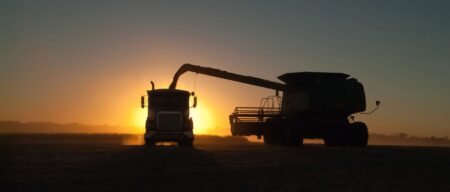As combines begin to roll across the Midwest this fall, some farmers are facing soybeans that are coming in at just 9–10% moisture. In areas like southern Illinois, Indiana, and Ohio — where moderate to severe drought has taken hold — fields are drying down even faster, and there’s little chance that rain will meaningfully raise grain moisture. While that may look like a dry, easy-to-store crop, Purdue Extension soybean specialist Shaun Casteel said harvesting soybeans this dry comes with real challenges for yield, quality, and harvest management.
Yield Loss in Water Weight
Unlike corn, for which elevators accept a wide range of moistures, soybeans have a much tighter window. Most buyers target 13% moisture, and once soybeans test below that level, any additional drying results in a permanent yield loss.
“We get paid on 60-pound increments, not on true bushels,” Casteel said. “If we bring in beans at 10% instead of 13%, we’re still selling a 60-pound unit — but we’ve lost up to three bushels per acre just from water weight.”
That tight window means farmers can go from acceptable 13% soybeans to 10% or lower in a matter of hours during hot, sunny days. Early-planted varieties, particularly early maturities, can dry down even faster, Casteel cautioned.
Harvest Efficiency and Thick Stems
Even when grain moisture is low, fields may still carry thick or tough stems. “The grain is ready, but you can’t always run super fast unless you’ve got a combine that can handle the flow and threshing,” Casteel said. In some cases, stems may look yellow from the outside but still be green on the inside, which slows harvest speed and puts more demand on the machine.
Low-moisture harvest also raises the risk of seed coat cracking and shattering, especially if the crop goes through multiple wet-dry cycles before it’s cut, Casteel explained. “Two or three cycles of wet, then dry, make pods brittle,” he said. “When the reel hits them or the cutter bar shakes, you’ll see more shatter loss at the head.”
Photo credit: XtremeAg
If rains persist, there’s also the possibility of precocious germination — soybeans sprouting in the pod. While seed coat cracking can impact seed bean germination scores, Casteel noted most of the bigger germination issues trace back to heat and moisture stress during seed fill, not the moment of harvest.
Adjusting Combines to Reduce Losses
When soybeans are down to 9–10%, careful adjustments matter. “Check where losses are occurring — at the head, on the ground ahead of the reel, or out the tail,” Casteel said. Fan speed is often the culprit; what worked for 13% soybeans can blow dry soybeans out the back. “Four or five seeds per square foot on the ground is about a bushel loss,” he added.
Should You Wait for Rain?
With forecasts calling for showers, some growers may wonder if it pays to wait. Casteel said growers should be cautious about delaying harvest. “If you’re at 10% moisture on a 70-bushel field, and you gain back three points with a rain, you might recover two bushels per acre,” he said. In drought-stricken regions, however, rain that could bring moisture back is often patchy and insufficient. He warned that once a field has gone through several wet-dry cycles — or once pods are brittle — waiting can invite bigger losses.
“It’s about knowing your fields, setting your combine, and making the best decision for the acres in front of you,” Casteel said.


:max_bytes(150000):strip_icc()/croppedLee20Lubbers20Wheat20Harvest-15706a7736474a8293d6fdcf8f025f00.jpg)
:max_bytes(150000):strip_icc()/SieversFarmDrone_0-e1760038242952-6c0ea1bb11e04d67adaea50a1bc8d603.png)
:max_bytes(150000):strip_icc()/CaseCombineHarvestingOnHill-WideShot-2-2000-5323a1ed14634f679027e940a1e80c70.jpg)


:max_bytes(150000):strip_icc()/grain_soybeans2-56caf5bb5f9b5879cc524628.jpg)
:max_bytes(150000):strip_icc()/Lee20Combine-2000-74f4b0472e2f4244a50679f9d4febb2f.jpeg)
:max_bytes(150000):strip_icc()/CaseCombineAndTractorHarvesting2-WideShot-2000-300009fbd0da4f08ac67aee726a10e90.jpg)
